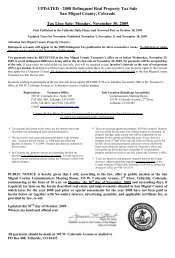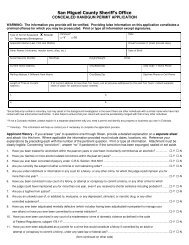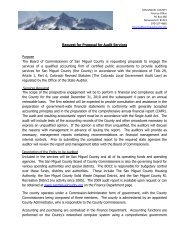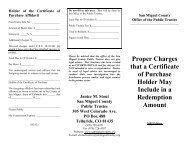colorado retail food establishment rules and ... - Boulder County
colorado retail food establishment rules and ... - Boulder County
colorado retail food establishment rules and ... - Boulder County
You also want an ePaper? Increase the reach of your titles
YUMPU automatically turns print PDFs into web optimized ePapers that Google loves.
longhorns, or any other forms of cheese have been damaged, cut <strong>and</strong> repackaged for display<br />
<strong>and</strong>/or sale, thereby exposing interior surfaces to possible contamination, the cut portions as well<br />
as the remaining cheese shall be held under refrigeration.<br />
6. Coffee Creaming Agents - All non-dairy coffee creaming agents in liquid form, except aseptically<br />
processed ultra high temperature (UHT) liquid coffee creaming agents.<br />
7. Cut Leafy Greens- Following 24 multi-state outbreaks between 1998 <strong>and</strong> 2008, cut leafy greens<br />
was added to the definition of potentially hazardous <strong>food</strong> requiring time-temperature control for<br />
safety (TCS). The term used in the definition includes a variety of cut lettuces <strong>and</strong> leafy greens.<br />
Raw agricultural commodities (RACs) that are not processed or cut on-site are excluded from the<br />
definition of cut leafy greens. Herbs such as cilantro or parsley are also not considered cut leafy<br />
greens. The pH, water activity, available moisture <strong>and</strong> nutrients of cut leafy greens supports the<br />
growth of <strong>food</strong>borne pathogens <strong>and</strong> refrigeration at 41ºF (5ºC) or less inhibits growth <strong>and</strong><br />
promotes general die off in some pathogens such as E. coli O157:H7. Salmonella, E. coli<br />
O157:H7 <strong>and</strong> Listeria monocytogenes, once attached to the surface or internalized into cut<br />
surfaces of leafy greens, are only marginally affected by chemical sanitizers.<br />
8. Cut Tomatoes- Historically, uncooked fruits <strong>and</strong> vegetables, such as cut tomatoes, have been<br />
considered non-PHF unless they were epidemiologically implicated in <strong>food</strong>borne illness<br />
outbreaks <strong>and</strong> are capable of supporting the growth of pathogenic bacteria in the absence of<br />
temperature control. The US Food <strong>and</strong> Drug Administration (FDA) has reported that since 1990,<br />
at least 12 multi-state <strong>food</strong>borne illness outbreaks have been associated with different varieties of<br />
tomatoes <strong>and</strong> additionally, from 1998-2006, outbreaks associated with tomatoes made up 17% of<br />
the produce related outbreaks reported to FDA nationwide. Salmonella has been the pathogen of<br />
concern most often associated with tomato outbreaks.<br />
9. Eggs - Cooked, cracked, fresh with outer shell removed, peeled hard-boiled eggs, <strong>and</strong> hard-boiled<br />
eggs with intact shells which have been hard-boiled <strong>and</strong> then cooled in liquid. Refrigeration of<br />
raw whole eggs in the shell is required.<br />
10. Garlic - Garlic in oil products.<br />
11. Mayonnaise or Other Acidified Salad Dressings - If the pH is above 4.6 <strong>and</strong>/or combined with<br />
other <strong>food</strong> products.<br />
12. Onions- Cooked <strong>and</strong> dehydrated that have been reconstituted.<br />
13. Pasta - All types that have been cooked.<br />
14. Pastries - Meat, cheese <strong>and</strong> cream filled.<br />
15. Pies - Meat, fish, poultry, natural cream, synthetic cream, custard, pumpkin <strong>and</strong> pies that are<br />
covered with toppings which will support microbial growth.<br />
16. Potatoes - Baked, boiled or fried.<br />
17. Rice - Boiled, steamed, fried, Spanish <strong>and</strong> cooked rice used in sushi.<br />
18. Sour Cream - If the pH is above 4.6 <strong>and</strong>/or combined with other <strong>food</strong> products.<br />
19. Soy Protein - Tofu <strong>and</strong> other moist soy protein products.<br />
20. Seed Sprouts - All types.<br />
FOODS WHICH ARE NOT POTENTIALLY HAZARDOUS ARE:<br />
1. Hard-Boiled eggs with shells intact which have been air-dried; <strong>and</strong><br />
2. Foods which have been adequately commercially processed <strong>and</strong> remain in their unopened<br />
hermetically sealed container.<br />
A - 7











